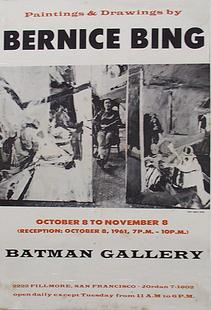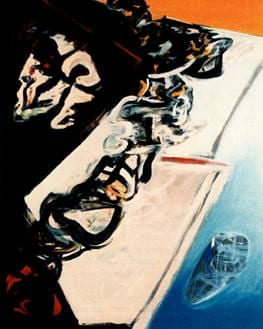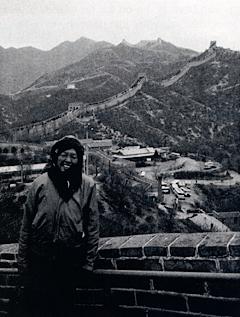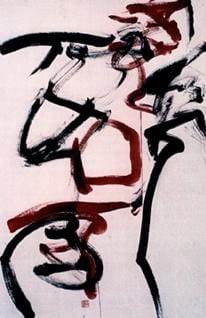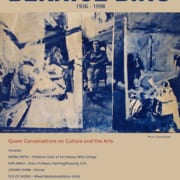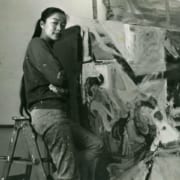A NARRATIVE CHRONOLOGY By Moira Roth
A NARRATIVE CHRONOLOGY
By Moira Roth
Based on a series of taped audio and video interviews with Bing in the fall of 1990 and summer of 1991, material in the artist’s archives, and quotations from Bing’s text in the exhibition catalogue, Completing the Circle: Six Artists; edited by Florence Wong and George Rivera, and sponsored by the Asian Heritage Council, Festival 2000, the Triton Museum of Art and Southern Exposure Gallery, 1990.
April 10, 1936
Bernice Bing is born in Chinatown, San Francisco. She knows relatively little of her family background except that on both sides the families come from southern China; one grandfather was a merchant, and an uncle a calligrapher. Her father, born and raised in China, emigrated to the U.S. and is in his thirties when Bing is born. Mother, born in the U.S., is age 18 at the time of Bernice’s birth; mother and mother’s sister work in Chinatown’s Follies; mother is a hat girl, and aunt a dancer.
1941
Mother dies of heart ailment. After mother’s death, Bernice and her sister are placed in a series of Caucasian foster homes; they also on occasion stay with their grandmother. In her memories of her childhood, Bing emphasizes the cultural differences she experienced. “My grandmother represented China, the old country, bringing over her feelings of anger and subservience, but her strength, too. She was a woman who had bound feet, bound at the age of five. I didn’t really know my mother but, of course she was my grandmother’s child…my mother had an ambitious life as a young woman but she was never able to fulfill herself completely because she died at the young age of twenty-three. For me there was the difficulty of being an Asian American child going to a basically very middle class white school, and trying to assimilate both of these cultures. I feel in many ways that art has been the means by which I was able to understand my two cultures.” Bing remembers as a child that she was rebellious and did not do well academically but possessed an early facility in drawing: “drawing was the thing that kept me connected.”
1957-1958
Attends California College of Arts and Crafts, Oakland, and initially enrolls as an advertising major; among her fellow students are Manuel Neri and George Miyasaki; her instructors include Nathan Oliveira, Saburo Hasegawa and Richard Diebenkorn. During her short stay at CCAC, Bing decides to become a painter and drops advertising. One of her most important encounters is with Hasegawa (who died around 1958), who had been brought over from Japan by the school. “Earlier on he had been very influenced by European painting and then he had studied Zen. He practiced Zen, and used his Zen meditation in his own art. His work was dreamy abstract and quite calligraphic and beautiful. He introduced a whole attitude that was completely foreign to me. I had no idea what it meant to be an Asian woman, and he got me started thinking about that. I was in awe of him. He would wear his traditional Zen robes — I don’t think I ever saw him in Western dress — a long black robe, and he would tell stories about how he would sit zazen, and how he would get whacked on the back for falling asleep! On the first day in his drawing class; he marked where we were sitting and then we had to sit in that same place during the whole semester. And the model would be in the same position all semester, too. We would draw that position until it was ingrained and etched in our heads. In Hasagawa’s class, we would do color theory with origami paper. His methodology of teaching was unique. He had a strong Japanese accent and it was hard to understand him because of that, and also because he talked in metaphors. He was such a contrast to Diebenkorn who was teaching there and had just begun to make a name for himself. Examples of two very different approaches to teaching art. Hasegawa’s emphasis was one of mental attitude, whereas the feeling I had from Diebenkorn was that of observing nature very physically. But there were some similarities between them which came together–at least in my development. Oliveira was also a very good teacher, very enthusiastic.”
After a semester Bing switches from CCAC to the California School of Fine Arts (which in 1960 becomes the San Francisco Art Institute). There were few Asian Americans at the school but one fellow student, with whom Bing becomes close friends, is Joanne Low Holley, a painter, and the niece of Charlie Low of the Forbidden City.
1958-1961
Receives BFA(1959) and MFA(1961) from the San Francisco Art Institute. Her class is the first Master’s program of the Institute, and it attracts many artists who later on become prominent in the Bay Area art scene, including Joan Brown, William T. Wiley, Robert Hudson, Leo Valledor, Alvin Light and Cornelia Schulz. Elmer Bischoff and Frank Lobdell are Bing’s main painting teachers. As a student, she supports herself by working in San Francisco’s North Beach at the Spaghetti Factory, where she also has a studio on the top floor. This is a lively time in the Bay Area art scene: such new experimental galleries as the Dilexi Gallery (1958-1970) are stressing Californian art; it is the time of the Rat Bastard Protection Association, a group organized in 1960 by Bruce Conner, whose members include Wally Hedrick, Jay de Feo and Fred Martin; Bing is close to them and to other young artists in the area. She remembers these as “real exciting times, lots of parties, drinking..de Kooning once came to a party..Funk had just started.”
In the 1990 Completing the Circle catalogue, Bing describes her impressions of the avant-garde of the late fifties: “…Among abstractionists, de Kooning, Kline, Motherwell, Still; in jazz, Coltrane, Ornette Coleman, Monk, Mingus; in poetry Stein, Pound, Genet, Rilke; in literature, Camus, Gide, Hesse, Mann, de Beauvoir; in the theater Beckett, Genet, Albee; and in art films, Bergman, Antonioni, Fellini. These were my mentors, muses, and totems.”
Zen Buddhism, through Suzuki’s books, spreads rapidly to the West Coast. Saburo Hasegawa, a Zen painter, was my first profound influence in Eastern thought. ‘To see without seeing’ was a concept totally foreign to me. There began my pursuit of more knowledge of the poetry and thought of Po Chu-i, Chuang Tzu, Lao Tzu, Shakyamuni, and Wan Hsi-chih, the ‘calligraphic sage.'”
1960
Accompanies Joan Brown, a close friend at this time, to New York, for Brown’s first one-person show at the Staempfli Gallery. Meets Duchamp at a party. “That was my most thrilling experience in New York.”
For Bing and Brown it is their first trip back East. In recalling this visit, Bing describes them as “just a couple of hicks from California but we were wined and dined. We went to the mansion of Alfonso Osorio on Long Island, and this was the first time I had seen Clyfford Still paintings, and, of course, Osorio also had Pollock, de Kooning and those artists. It was the first real exposure to such for Joan and me–and we also went to the Museum of Modern Art to see the ‘biggies.'”
Is included in San Francisco Annual Exhibition, San Francisco Museum of Modern Art.
1961
One-person exhibition at the Batman Gallery, a well-known short-lived alternative space on Fillmore Street, San Francisco. Alfred Frankenstein reviews this in the San Francisco Chronicle: “Bing… has a remarkable gift for fluid line…carried to the verge of abstraction in some extremely good small drawings. Her paintings are huge and are most remarkable for the majestic sternness of their blacks and reds…”
1963-1966
In July 1963 is written up in Artforum (at that time based in San Francisco) by James Monte who comments that Bing’s “student work shows a remarkable amount of inventive freedom within the confines of Bay Area realism.” That year Bing moves to Mayacamas vineyards, some 75 miles outside San Francisco, to assume the position of caretaker for three years. “I’d never been in the country before. It was a big adjustment from city life to country, and very productive. It was also somewhat isolated…I just dropped out of the scene. “During her three years in Mayacamas, Bing produces many paintings–whose images she describes as “abstract organic”–but most of these canvases are now lost.
Travels from Mayacamas to Berkeley for her two-person exhibition with Margo Campbell at the Berkeley Gallery: Elmer Bischoff and other well-known artists attend her opening.
1964
Again, Bing receives a review in Artforum (May 1964) in response to the Berkeley Gallery exhibition. The anonymous reviewer writes that Bing is “just beginning to come to terms with the rugged landscape (of Mayacamas). Her 12 paintings, selected from 20 recently completed, are something of a biography. The earliest works though competently painted, are completely detached views of the expanse of valley from a mountain top–lifeless without the foil of a figure. But in #12 and #13, done in October and November of 1963, Miss Bing begins to see the landscape as environment, and to enjoy it as such. She loses the dry, still-life-of-mountains approach and responds with genuine enthusiasm to the plastic movement of a rock-face, a sweep of hilltop, or an upland meadow.”
1966
Is included in San Francisco Annual Exhibition, San Francisco Museum of Modern Art.
1967
Bing is one of twelve people in the first residential program of Esalen in Big Sur; the program lasts for nine months: Esalen has just been founded as a center for New Age psychology and philosophy; Bing meets, as she phrases it, “All the greats.” She hears and meets Abram U. Maslow, Joseph Campbell, Alan Watts and Ronald D. Laing, and works closely with Fritz Perls, the New Age psychologist, with whom she becomes friends. She produces small canvases at this time (most have disappeared) and keeps a journal; it is here that she first learns meditation techniques. “It was amazing for someone who had been in the country three years after art school to come into such a totally bizarre environment, an ideology, a philosophy of people who had been working for years and years in psychoanalysis, parapsychology, psychic phenomena and mysticism–they didn’t like the word occult. There was so much to be said. We didn’t have the information at the time, very little had been published about it. It was very exciting. I had not been that well-read before but I was very interested in all of this stuff primarily because I had already been reading a lot of Jung on my own in Mayacamas. I read the Bollingen lecture series. I was very impressed with his use of imagery: I read his autobiography, Dreams, Memories and Reflections, and was impressed with what this man was able to bring out from the so-called unconscious, the dream world; the fascination Jung had with cultures from all over the world. He was really a universal thinker. The whole concept of Esalen was to delve into a person’s psyche in depth in the same manner as drug experiences, to break down certain superficialities in order to reach the essential self. That was really fascinating to me. There was so much happening then at Esalen: talk of color auras, states of meditation and alpha freedback. There were those experiments being done at the time by a Japanese physiologist at the University of California, who recorded the alpha feedback of Zen monks, and discovered that the alpha state is that meditative state. As residents we were hooked up to a very primitive machine to record alpha–there would be a zapping sound if one reached it!”
1968-1969
Serves on panel, National Endowment for the Arts Expansion Program in Washington D.C. “It was when Nancy Hanks was head of the endowment and she was the catalyst in bringing people of color into the Expansion Arts Program–and I was involved in the Neighborhood Arts Program. Politically, I was absolutely naive. I didn’t know what they were talking about but I could give them feedback about what I knew in my area.”
1969-1971
During this period, Bing works with the Neighborhood Arts Program (a concept developed in the mid-1960s by June Dunn) whose mission is to bring arts into local communities. Loni Ding, the film maker, leads a youth workshop in San Francisco’s Chinatown, and Bing works as her assistant; this is the first time since her childhood, that Bing has been immersed in the Chinese-American community. “We developed the street fairs and art exhibitions in Chinatown.” In 1970, she is appointed the Neighborhood Arts Program District Organizer for the Chinatown-North Beach area.
1970
Teaches for one year at the California College of Arts and Crafts, her alma mater.
1972-1976
Is appointed a Comprehensive Employment and Training Act (CETA) artist; CETA is a federal job’s program which grants money to cities or other jurisdictions to hire and train the unemployed, and at this time supports many artists in the Bay Area. In 1975, Bing and two other artists, under the auspices of the Neighborhood Arts Program and CETA, create the Scrounger Center for Reusable Art Parts (SCRAP); they scrounge for material and accumulate huge collections of rolls of paper, rags, etc., out of which they form junk sculpture at Pier 3 in San Francisco’s Fort Mason. Leaves CETA to work for the California Arts Council.
1976
Is included in Other Sources: An American Essay, at the San Francisco Art Institute, curated by Carlos Villa, which consists of an exhibition, and series of talks and events. It is an ambitious attempt to study the cultural diversity of the city’s art scene.
1980-1984
Bing is appointed the Director, Program Director and Building Manager of South of Market Cultural Center (SOMAR), run under the San Francisco Arts Commission; SOMAR is one of four cultural centers at this time. Under Bing’s leadership, it receives nonprofit status, and she helps develop the space, and expands the programs; “We wanted to bring in some new blood, young artists.” She introduces her exhibition program with an exhibition of 19 artists, graduates of the SFAI, a modern Salon des Refusés of artists who had not been included in the official SFAI celebrations of its 110th anniversary (In Art News, May 1981, Thomas Albright praises the installation “the cavernous warehouse that the San Francisco Arts Commission Neighborhood Arts program operates as the South of Market Cultural Center.”) Bing arranges a concert by the Sex Pistols, which caused quite a stir. Under her directorship many varied exhibitions, workshops and presentations are sponsored by SOMAR.
During these 4-5 years at SOMAR, Bing is unable to paint much as administrative duties take her time and energy. She decides to leave due to the tensions of her position, and her desire to immerse herself again in art making.
1954-1985
For a three month period Bing visits Korea, Japan, and China. In China, she studies calligraphy and painting at the Zhejiang Academy in Haungzhou. “My first immediate experience in China was that I suddenly realized that I was in the majority yet, also, though I had the same skin color, I was a stranger. My posture, my dress was different, my accent was quite different–everyone knew I was a foreigner.” She is struck by the experiences of China’s past and present. “…The vastness of the country, the sense of the monumentality and oldness of China. In the countryside the people were still tiling the field with oxen, the laborers with bamboo tools…here we are in the twentieth century and this had been going on for thousands of years. The archaeological finds were just phenomenal. The Imperial courts, the Summer Palace were built with such genius, with such a great knowledge of sound and space, cosmology and the sense of cosmic heavens.” Bing studies with a traditional landscape painter. “He would give us traditional exercises where one week you would do nothing but rocks, imitating the old brush strokes depicting these rocks. Then you would do trees or a cloud. The calligraphy was the same thing. You took the old rubbings in the books and would copy the style. You would have a big brush and do big characters. Then you would go to the gardens, and draw and paint there.”
1985
Upon her return, she moves from San Francisco to Philo, a small town in Mendocino, California, where she has now lived for some seven years. She supported herself first as a waitress and cook, and now works as a counselor at a youth rehabilitation center, while painting regularly in a small outdoor studio near her apartment. In the 1990 Completing the Circle catalogue, Bing writes: “Recently, since my return from a trip to China, I have made a path to my heart with Chinese calligraphy.” She often works on paper: “I use calligraphy as a way of practicing meditation, almost as a warm-up exercise.” (She has been a practicing Buddhist for the last decade or so.) Bing also creates large oil paintings, again using calligraphy as the base for the images.
1988
Is included in two-woman show, Winona Gallery, Mendocino.
1989
Bing joined the newly founded Asian American Women Artists Association, a Bay Area group with some 70 members, and regularly comes in from Philo to attend the meetings. “I am usually one of the first to avoid groups but since I lost my sister to cancer in 1980, I missed a connectiveness with other Asian Women, so I felt very excited to find the group. The excitement of young and older women together, and from different countries–China, Japan and Korea. I also feel politically it is very important to have this group right now. I really believe in the group.”
1990 Bing is one of six artists selected for Completing the Circle, an exhibition of Northern California Chinese American artists held at the Southern Exposure Gallery in San Francisco. This groundbreaking exhibition is accompanied by a substantial bilingual catalogue which contains a text by Bing.
1990-91
Prepares for the large one-person show at SOMAR Gallery, San Francisco.

